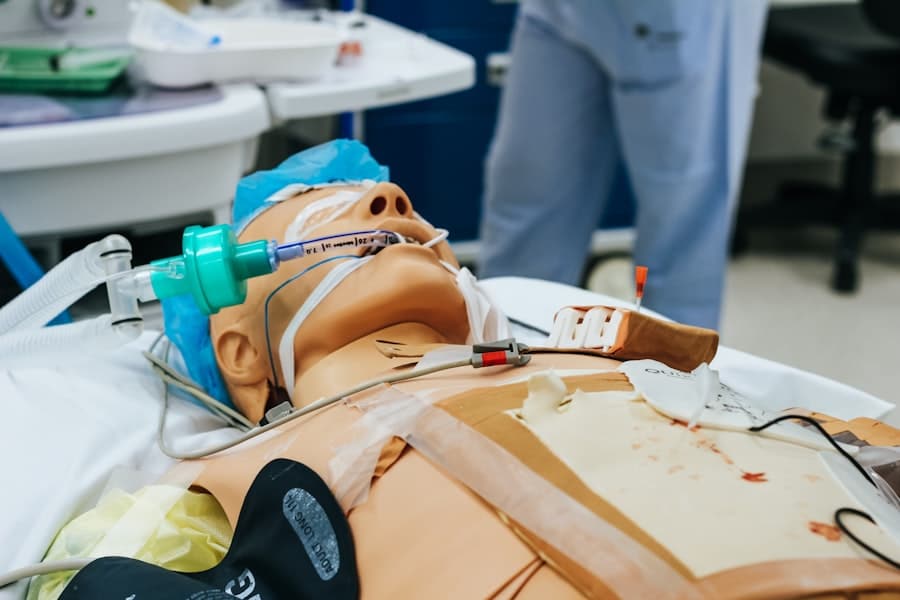Virtual Reality (VR) has emerged as a transformative technology in various sectors, and healthcare is no exception. The integration of VR into healthcare training represents a significant shift in how medical professionals acquire skills and knowledge. Traditionally, medical education relied heavily on textbooks, lectures, and hands-on experience in clinical settings.
However, these methods often fall short in providing immersive, real-world experiences that are crucial for developing the competencies required in high-stakes environments. VR offers a solution by creating simulated environments where learners can practice procedures, interact with virtual patients, and hone their skills without the risks associated with real-life practice. The application of VR in healthcare training is not merely a trend; it is a response to the evolving needs of the medical field.
As healthcare systems become increasingly complex and patient populations more diverse, the demand for well-trained professionals who can adapt to various scenarios is paramount.
This innovative approach not only enhances learning outcomes but also fosters confidence among healthcare providers as they prepare for real-world interactions.
Key Takeaways
- VR in healthcare training offers immersive and interactive learning experiences for medical professionals.
- Advantages of using VR in healthcare education include increased engagement, realistic simulations, and safe practice environments.
- VR simulations for surgical training provide a risk-free environment for practicing complex procedures and improving surgical skills.
- VR is used for patient care and communication skills training to enhance empathy, bedside manner, and patient interaction.
- VR is utilized for medical diagnosis and treatment planning to visualize complex medical data and improve decision-making processes.
Advantages of Using VR in Healthcare Education
One of the most significant advantages of VR in healthcare education is its ability to provide experiential learning opportunities that are both safe and effective. In traditional training environments, students may have limited access to patients or may only observe procedures rather than actively participate. VR circumvents these limitations by allowing learners to engage in realistic simulations where they can practice skills repeatedly until they achieve proficiency.
This hands-on experience is invaluable, particularly in high-stakes fields such as surgery or emergency medicine, where the margin for error is minimal. Moreover, VR can cater to various learning styles, making it an inclusive educational tool. Some individuals may excel in visual learning environments, while others may benefit from kinesthetic experiences.
VR accommodates these differences by offering interactive scenarios that engage multiple senses. For instance, a surgical trainee can visualize anatomy in three dimensions while simultaneously manipulating virtual instruments, thereby reinforcing their understanding through active participation. This multi-faceted approach not only enhances retention of information but also promotes critical thinking and problem-solving skills essential for effective patient care.
VR Simulations for Surgical Training

Surgical training has historically been one of the most challenging aspects of medical education due to the inherent risks involved in live procedures. VR simulations have revolutionized this aspect by providing a safe platform for trainees to practice complex surgical techniques without jeopardizing patient safety. These simulations can replicate a wide array of surgical scenarios, from routine procedures to rare complications, allowing learners to experience a breadth of situations that they may not encounter during their training.
For example, platforms like Osso VR and Touch Surgery offer immersive surgical simulations that allow trainees to perform procedures such as laparoscopic surgeries or orthopedic interventions. These platforms utilize haptic feedback technology, which simulates the tactile sensations of performing surgery, thereby enhancing the realism of the training experience. Trainees can receive immediate feedback on their performance, enabling them to identify areas for improvement and refine their skills over time.
This iterative learning process is crucial for building the dexterity and confidence required for successful surgical practice.
VR for Patient Care and Communication Skills Training
In addition to technical skills, effective communication is a cornerstone of patient care that is often overlooked in traditional medical training. VR provides an innovative solution for developing these essential interpersonal skills by immersing trainees in realistic patient interactions. Through role-playing scenarios with virtual patients, healthcare professionals can practice their communication techniques, empathy, and bedside manner in a risk-free environment.
For instance, programs like Mursion utilize VR to create lifelike simulations where trainees can engage with virtual patients experiencing various emotional states or medical conditions. This allows learners to practice active listening, empathy, and appropriate responses to patient concerns. The ability to rehearse these interactions helps build confidence and prepares healthcare providers for real-life situations where effective communication can significantly impact patient outcomes.
By honing these skills through VR training, healthcare professionals are better equipped to foster trust and rapport with their patients.
Using VR for Medical Diagnosis and Treatment Planning
VR technology also plays a pivotal role in enhancing diagnostic skills and treatment planning among healthcare professionals. By simulating complex medical cases, VR allows trainees to engage in critical thinking exercises that mirror real-world decision-making processes. This immersive approach enables learners to explore various diagnostic pathways and treatment options while considering patient-specific factors.
For example, platforms like Medical Realities offer VR scenarios where trainees can analyze patient data, conduct virtual examinations, and formulate treatment plans based on simulated clinical presentations. This hands-on experience not only reinforces theoretical knowledge but also encourages learners to think critically about their decisions and the potential consequences of their actions. As a result, healthcare professionals become more adept at navigating the complexities of patient care and are better prepared to make informed decisions in high-pressure situations.
Challenges and Limitations of VR in Healthcare Training

Despite its numerous advantages, the integration of VR into healthcare training is not without challenges. One significant limitation is the high cost associated with developing and implementing VR technology. Creating realistic simulations requires substantial investment in software development, hardware acquisition, and ongoing maintenance.
Many educational institutions may struggle to allocate sufficient resources for such initiatives, leading to disparities in access to VR training opportunities. Additionally, there is a learning curve associated with adopting new technologies like VR. Healthcare educators must be adequately trained to incorporate VR into their curricula effectively.
Resistance to change among faculty or institutions accustomed to traditional teaching methods can hinder the widespread adoption of VR in healthcare education. Furthermore, ensuring that simulations accurately reflect real-world scenarios is crucial; poorly designed simulations can lead to misconceptions or inadequate preparation for actual clinical situations.
Future Trends and Developments in VR for Healthcare Education
Looking ahead, the future of VR in healthcare education appears promising as advancements in technology continue to evolve. One notable trend is the increasing use of artificial intelligence (AI) alongside VR to create adaptive learning experiences tailored to individual trainees’ needs. AI algorithms can analyze performance data from VR simulations and provide personalized feedback or adjust difficulty levels based on each learner’s progress.
This level of customization enhances the effectiveness of training programs and ensures that learners receive targeted support. Moreover, as VR technology becomes more accessible and affordable, we can expect broader implementation across various healthcare disciplines. Collaborative training environments where multiple learners can interact within the same virtual space are also on the horizon.
This could facilitate teamwork training among healthcare professionals, emphasizing the importance of collaboration in delivering high-quality patient care. As these trends continue to develop, VR will likely play an increasingly integral role in shaping the future landscape of healthcare education.
The Impact of VR on the Future of Healthcare Training
The impact of virtual reality on healthcare training is profound and multifaceted. By providing immersive learning experiences that enhance technical skills, communication abilities, and diagnostic acumen, VR is reshaping how medical professionals are educated. While challenges remain regarding cost and implementation, the potential benefits far outweigh these obstacles as technology continues to advance.
As we move forward into an era where healthcare demands are ever-increasing, embracing innovative solutions like VR will be essential for preparing future generations of healthcare providers. The ability to simulate complex scenarios safely and effectively will not only improve individual competencies but also contribute to better patient outcomes across the board. The integration of VR into healthcare education signifies a commitment to excellence in training that will ultimately benefit both practitioners and patients alike.
In a recent article from Hacker Noon, they cover a range of topics across the tech sector that are relevant to the discussion of virtual reality in healthcare training. The article delves into various advancements and innovations in technology that are shaping the future of different industries, including healthcare. To read more about the latest trends and developments in the tech sector, check out the article here.
FAQs
What is VR?
VR stands for virtual reality, which is a computer-generated simulation of an environment that can be interacted with in a seemingly real or physical way by a person using special electronic equipment, such as a helmet with a screen inside or gloves fitted with sensors.
How is VR used in healthcare training?
VR is used in healthcare training to simulate realistic medical scenarios, allowing future healthcare professionals to practice and improve their skills in a safe and controlled environment. This can include surgical simulations, patient interaction scenarios, and medical emergency simulations.
What are the benefits of using VR in healthcare training?
The benefits of using VR in healthcare training include the ability to provide realistic and immersive training experiences, the opportunity for repetitive practice without risk to real patients, the ability to customize training scenarios to specific learning objectives, and the potential for cost savings compared to traditional training methods.
Are there any limitations to using VR in healthcare training?
Some limitations of using VR in healthcare training include the initial cost of equipment and software, the need for technical support and maintenance, the potential for simulation sickness in some users, and the challenge of integrating VR training into existing curriculum and accreditation requirements.
What is the future potential of VR in healthcare training?
The future potential of VR in healthcare training is vast, with ongoing advancements in technology and software leading to increasingly realistic and effective training simulations. VR has the potential to revolutionize the way future healthcare professionals are trained, ultimately leading to improved patient care and outcomes.

